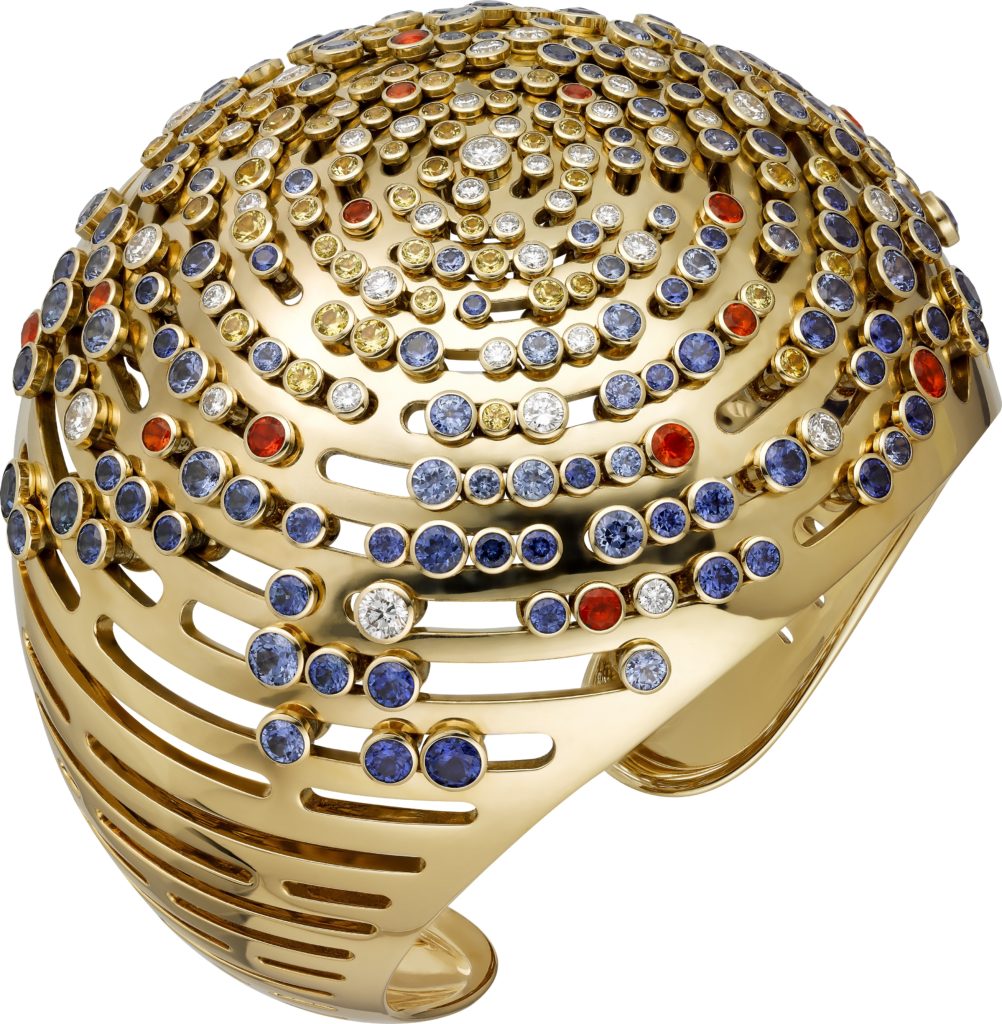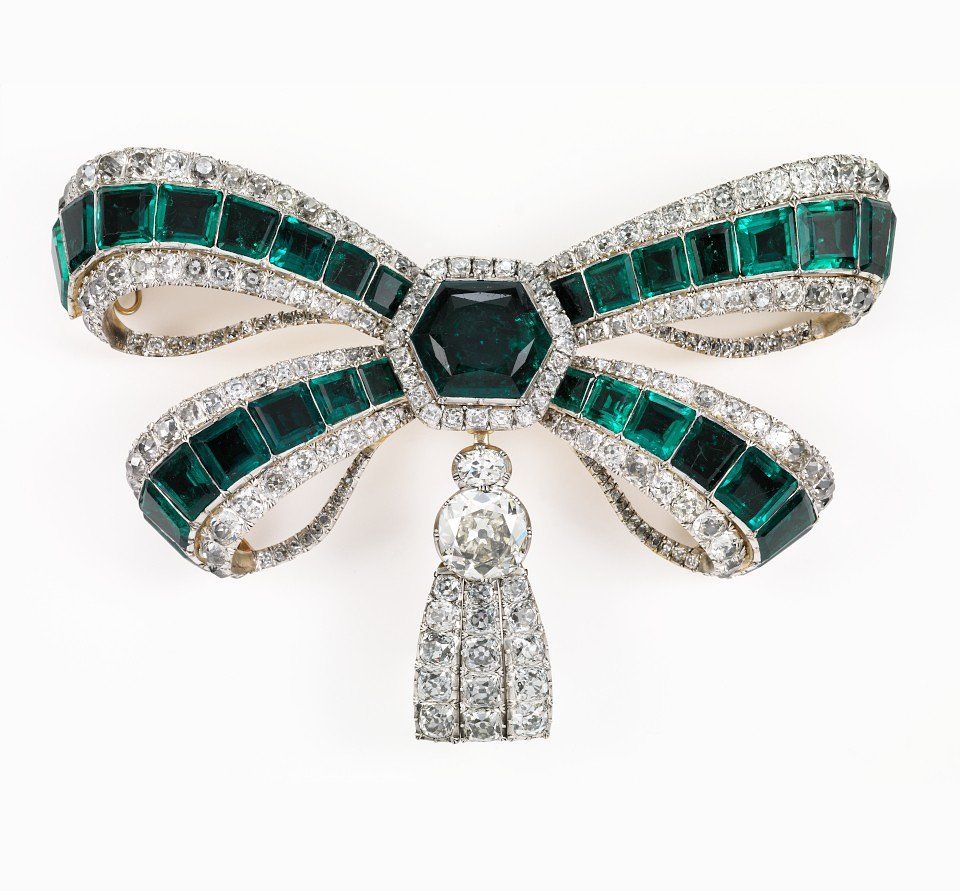As far back as I can remember, I have always loved autumn. Although I love all seasons, I’ve taken a liking to this one because of the colours: the yellow, the orange, the shimmering, warm hues everywhere. A few years ago, I was interested in seasonal jewellery, and more specifically in American jewellery that is worn on a one-off basis for an annual event. As the ghosts start to appear, the leaves start to fall, the first autumn storms arrive, the PSL is back in all the good cafes and the witches are warming up their broomsticks, I thought you might like a little selection of Halloween jewellery. Please note that this is not fancy jewellery, but rather creations made by both well-known jewellery houses and young jewellers who have been celebrating the season of sweets and falling leaves for the past few days!
Gold and diamond pumpkin brooch. Photo: Carnet Jewelry
1- The origins ofHalloween
For many people, Halloween is a commercial holiday. It is true that in Europe, and particularly in France, it does not arouse anything in us. And this is quite normal. Halloween is not part of our culture and I can only advise you to go and experience this holiday in an Anglo-Saxon country once in your life! It is celebrated mainly in the USA, the UK, Ireland, Canada, Australia and New Zealand. Its name is a contraction of the English All Hallows-Even which means the eve of All Hallows’ Day in contemporary English. It can be translated as ‘the eve of all saints’ or ‘the eve of All Hallows’ Day’. Although its name is attached to a Christian tradition, it is now a pagan festival. It is celebrated on 31 October. In France, All Saints’ Day is celebrated. On 2 November, we traditionally place flowers on the graves of our forefathers.
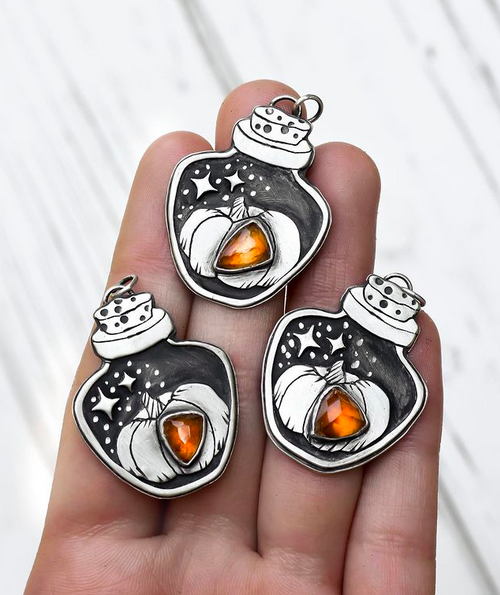
Potion pendants in silver and Hessonite garnets, by The Sylvan Smith. Photo: The Sylvan Smith
Many historical sources and cross-references also link it to the Celtic celebration of Samain, a very important time for these people as the date of November 1st represents the beginning of the dark period. This transitional festival is also meant to be an opening to the other world, that of the gods and spirits. Its etymology could, according to some, mean the end of summer, but this interpretation is still open to interpretation. It is mentioned in many Irish epic tales because, by definition, it is a time for magical and mythical events. But Halloween is also known as Oiche Shamhna in Gaelic, which can be translated as “the night of Samhain”. The exact origin of this festival or celebration is therefore lost in the mists of time. The cultural links between Halloween and Samhain are definitely present despite notable differences. In England, it was even referred to as the “night of the crunchy apple” or “night of the hazelnut”. People gathered around a fire to tell stories. Poor people were given biscuits called “spirit cakes”.

Silver, copper and rose quartz coffin pendant. Photo and design by Lisa J. Designs
This tradition can be found elsewhere and outside the Anglo-Saxon countries. For example, in the north of the Moselle (eastern France), in the Pays de Nied, the Rommelbootzennaat is celebrated. Behind this word, which is difficult to pronounce, lies a festival which means “the night of the squeaking beets” in Francique Lorrain. This Celtic tradition was maintained in German-speaking Moselle when the Celtic language and traditions were eclipsed by Germanic culture. On the eve of All Saints’ Day, grinning heads are carved out of beetroot, as this vegetable marks the end of work in the fields. Illuminated by candlelight, the heads are placed on windowsills, wells, cemetery walls or at road crossings to frighten passers-by. This tradition can be found in Switzerland with the Räbeliechtli festival where raves are carved. In the book by Le Braz – “La légende de la mort en Basse-Bretagne” (The legend of death in Lower Brittany) written in 1893, we find mention of an old tradition now lost in Brittany. On the eve of All Saints’ Day, food was left on the table and above all a log was left in the fireplace. This allowed the returning souls to feed and warm themselves before leaving… This notion of food is found today in the sweets that children ask for. For if we do not satisfy the spirits, they turn out to be teasing.

Silver Graveyard and Undead Pendant and Agate Feather Point Graveyard. Photo and production: Appaloosa Designs Jewelry
2- What about Jack-o’-Lantern?
Pumpkins, beets, beets, banquets, food offerings for the dead, vegetables and food are all part of the tradition of this time of year dedicated to the spirits. For most of us, Halloween is a scary pumpkin. But where does this representation come from?
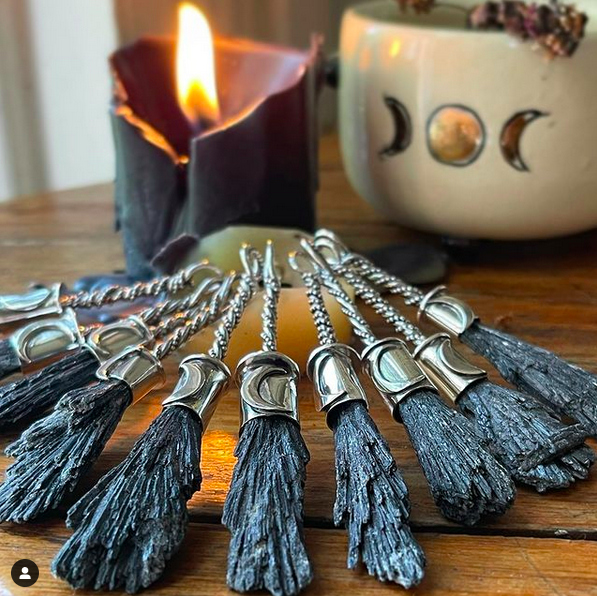
Broom Pendants in silver and raw black cyanite. Photo and design: The Dwelling Gem
Douglas Harper, in his etymological dictionary, gives a date of 1660 for the appearance of the term. Jack-o’-lantern is then a watchman, a night watchman. It is also said that this term is used as a variation of the term will-o’-the-wisp, which describes a will-o’-the-wisp, a manifestation often seen as magical, but which is explained by the spontaneous combustion in the open air of joint emanations of gases containing methane and phosphorus, emitted by the decomposition of organic matter such as corpses. This explains why they were mainly seen in cemeteries when the dead were not properly buried. The term is an old one, most likely derived from oral tradition, as it is found in Jonathan Swift ‘s A Tale of a Tub in 1704.

Silver, jade and amber pumpkin pendant. Photo and design: Lisa J. Designs
Jack is an ancient character most likely originating from a very old Irish legend about Stingy Jack, a clever drunkard known for his pranks and cheapness, and the devil. The devil comes to take him away and punish him. But Jack tells him he wants a last drink before following him. So the devil turns into a sixpence coin. Jack slips the coin into his purse where there is a silver cross and the devil is taken prisoner. He promises not to come and see him for the next ten years. Time passes and Jack meets the Devil again on his way. To escape again, he asks him to help him pick an apple. Taking advantage of this moment, Jack draws a cross on the tree again and traps the devil once more. The devil is forced to give up taking this soul. But the moment comes when Jack dies. Heaven refuses him because of his dissolute life and hell closes its doors to him because of an old promise. He has to retrace his steps. It is so dark that the devil gives him a turnip with a candle in it, forcing him to wander aimlessly until the day of judgment. It is said that he reappears every year on the day of his death, 31 October.

Silver ghost pendants. Photo and design by Sue “Lulu Bug jewelry” Urquhart
The use of the pumpkin in American tradition dates back to the 17th century when the Pilgrims Fathers arrived on the shores of Massachusetts, fleeing the Wars of Religion in Europe. The vast majority of these immigrants, who were Protestants, died of scurvy. They only survived thanks to the intervention of members of the Wampanoag people who helped them to grow corn and squash, two vegetables (of many varieties) endemic to the American continent. Governor William Bradford invited the settlers to celebrate three days of thanksgiving. The colonists invited the Indians to share a meal, and the Indians brought wild turkeys. Thanksgiving was born. For Halloween, we have to wait for the arrival of the Irish fleeing the great famine between 1845 and 1852 where potatoes and other vegetables were contaminated by mildew. When they arrived on the east coast of the United States, they brought with them their traditions, including this famous festival. The pumpkin, easier to carve, became the symbol of Halloween across the Atlantic.
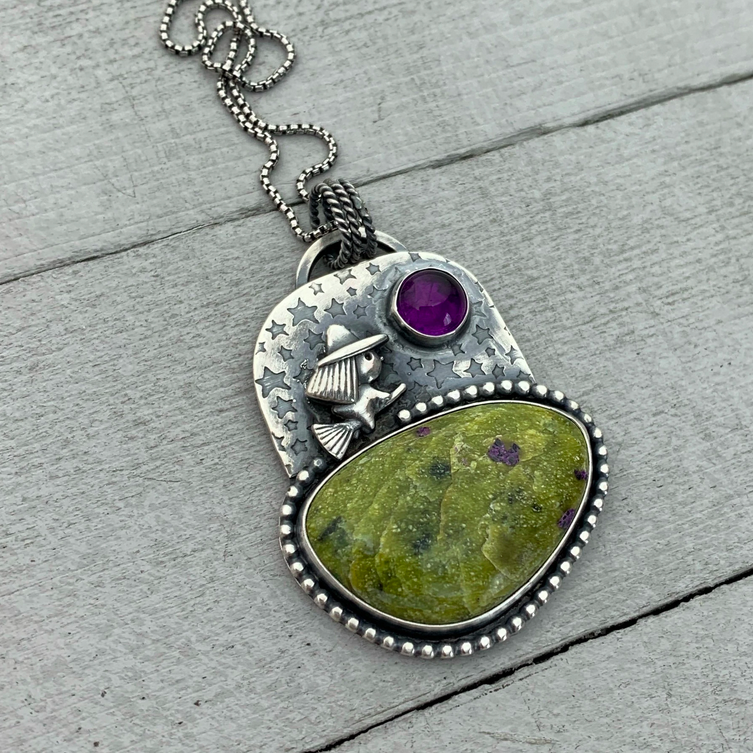
Witch pendant, silver, amethyst and stichtite serpentine. Photo and design: Sunlight Silver Jewelry
See you soon!
See you soon!






